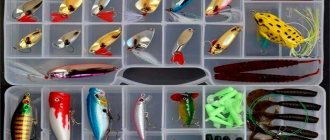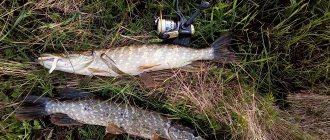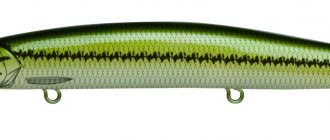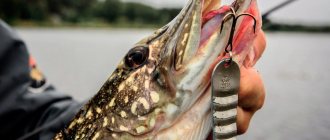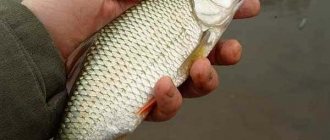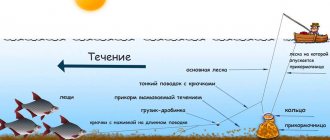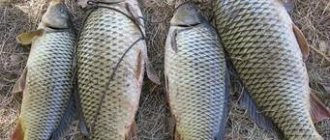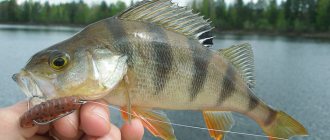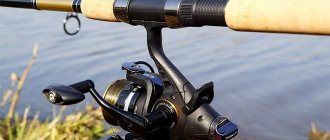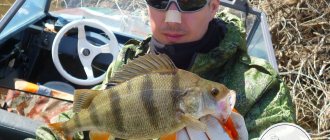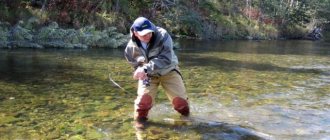Characteristics, features of the cicada
Cicadas are made from copper, bronze, brass and steel.
In the classic version, the cicada is equipped with two or one doubles in sizes from No. 10 to No. 2 according to the European classification, depending on the weight of the spoon. It has up to five holes on the body in the front upper part for attaching to spinning gear, which allow you to change the game of the bait when retrieving.
Changing the holes changes the depth of the spoon and the frequency of its vibrations. So:
- Heavy cicadas, attached to the holes farthest from the head, are used to fish holes at a depth of up to 20 meters.
- Small ones are used for catching perch under the surface, with a hook on the first couple of holes.
- The middle ones are caught with “half-water” hooks in the middle holes.
These spoons are used all year round. They are used in summer and autumn with spinning from the shore and trolling, in winter in clear water and from ice.
The use of different sizes of spinners depends, first of all, on the fishing conditions, from the weather, the strength of the current and ending with the time of day. For ice fishing, standard doubles are changed by installing one or two sizes larger.
Unique Characteristics of the Cicada
The Cicada spinner is a unique artificial bait that is excellent for catching predatory inhabitants of the depths, in particular perch. The striped hunter reacts to such a product with particular greed, and phenomenal activity is noticed at any time of the year, even in winter.
Due to its unique structure and shape, the cicada combines some of the features of balancers and wobblers. It has one or two hooks, which is typical for balancers, but when retrieved it performs a beautiful and specific game, which is demonstrated by wobblers.
There is an opinion in the fishing world that ideal and universal lures are a fiction, because each model is suitable for specific situations and fishing conditions. Nevertheless, in the arsenal of experienced fishermen there are “secret” products that are truly effective almost everywhere and always. And Cicada is a clear confirmation of this. It differs significantly from others in its shape, structure and catchability, so even the most expensive baits are not able to outplay it.
If you prefer spinners , then for productive fishing in winter, when the fish become inactive, lazy and capricious, you will have to change several different models to find the ideal option. In addition, when fishing in snags with an abundance of stones, large objects and other underwater obstacles, there is a risk of expensive gear breaking. Therefore, the Cicada spinner can be an excellent alternative, suitable for both novice fishermen and true professionals.
Cicada has been sold in retail outlets for more than ten years, but many fishermen are not even aware of its existence. Perhaps this is explained by the fact that only a few have been able to evaluate all the advantages of this bait in real conditions.
Other fishermen have known about this product for a long time, but do not pay due attention to it, believing that it is no different from others. However, such a spoon has excellent catchability, so catching perch with a cicada in winter will always give a good result. Moreover, you can use both spinning tackle and the vertical trolling method.
Other important things about the cicada
- Nature of the game. When cast with a spinning rod, the bait vibrates with a large amplitude, creating quite strong hydroacoustic waves in the water that attract predatory fish.
- The cicada is characterized by a high range. Possessing a compact shape that does not have sailing elements, as well as the concentration of most of the weight in the lower front area of the bait, the cicada flies very far when casting.
- When selecting the correct wiring for a given reservoir, you periodically need to change the location where the bait is hooked to one of the three holes, changing the play of the spinner.
- Basically, the cicada behaves like a jig bait, popping up quite actively when retrieved, which must be taken into account when selecting retrieve speeds.
- Thanks to the flattened shape of this spoon, in strong currents it can be used for rafting over long distances, increasing the fishing area.
- You can catch pike, perch, pike perch and any other predator using a cicada. The game of this spinner is especially attractive for pike. By putting pieces of fish on hooks, you can increase your fishing efficiency by half.
Optimal spinner size
The question of choosing the appropriate size of Cicada is very simple and straightforward. Manufacturers decided to simplify it, recommending that fishermen be guided by the following principle:
- For big water use a big bait.
- For small ones - small.
This refers to the depth in a specific place in the reservoir where fishing will take place.
However, many experts argue that it is preferable to take light and delicate products when deep-sea fishing, and heavier ones when examining the upper layers. This is explained by the unique characteristics of the fish itself, which shows not only increased curiosity, but also caution associated with a well-developed instinct of self-preservation.
In order not to leave the pond without a catch, the fisherman needs to constantly be creative, changing the pace, speed and method of placing the bait. Don't forget that nothing is the same in the real world, so the more options you have for presenting potential prey, the higher your chances of a successful bite in specific circumstances.
If you are using a 5 gram Cicada, then you need to throw it a little further than a 3.5 gram product. To attract fish, you can try tapping the bait on the bottom. The bass will probably suck on its food, so when it notices a strange movement, it will most likely want to swallow it. In most cases, the striped predator rushes at the Cicada when it is raised up, which is why experienced fishermen equip the lure with an additional hook in the tail area. However, this significantly increases the likelihood of snagging on water obstacles and vegetation, so you should not lower the bait directly to the bottom, it is better to move it quickly.
Experienced fishermen note one curious fact: minke whales that are found near the bottom behave much more cautiously than those that prefer to hunt closer to the surface. In the depths, perch more actively rushes to sink food, so fast retrieval is quite suitable for it.
Main manufacturers and popular models of cicadas
There are mainly two types of cicada spinners on our market: those produced by the Dutch company Heddon under the name SonnarFlach and the American models Rut Runner by DAM - this is an analogue of the Dutch Sonnar called Cicada. The model is popular when fishing for pike perch, especially during autumn cold snaps and in winter in open water.
If you want to find out what gear pike perch bites best with, you can read our article.
American cicadas have mostly taken root in Russia. This is an interesting bait, which many other species of predatory fish are actively interested in. Small cicadas are also used to actively and purposefully catch roach, ide, chub and other types of non-predatory fish.
Some popular models:
Grows Culture 6008 - produced in 6 types in weight versions from 3.5 grams to 14. Each weight version is presented in 20-35 colors. As one cicada fan said, “Catches anything that floats.”
Grows Culture 6020 is a heavy spoon weighing 28 grams, for catching pike and large pike perch in deep holes and in strong currents.
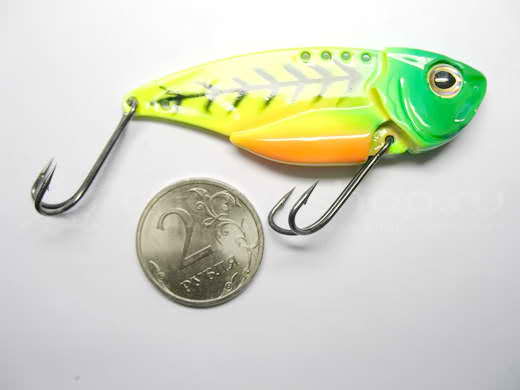
Takara 3503, 3508, 3505 – a medium-weight spinner, you can catch any fish in calm waters, as well as in medium-strong currents.
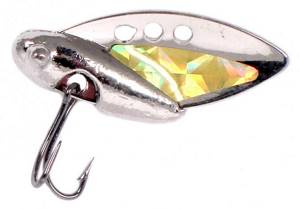
GT-BIO Prado Vib – size 42 mm, weight 10 grams, color – gold. Catches pike perch and large perch, used at medium depths. With a uniform average speed, it catches medium-sized pike.
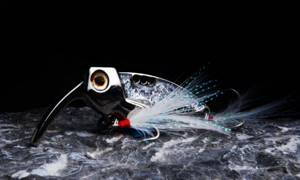
Gackal SUSUKE BLADE Jr – weight 8 grams, is a “noisy bait”. It catches pike perch, perch, and pike; the success of this spoon is determined by the rustling noise when retrieving. The noise is produced by chambers with plastic balls at the location of the eyes.
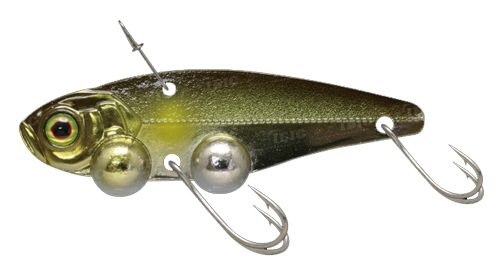
SPRO TEPPAN VIB 10GR AYU – wide choice of wiring due to four holes in the back. Catches pike and pike perch, sometimes large perch.
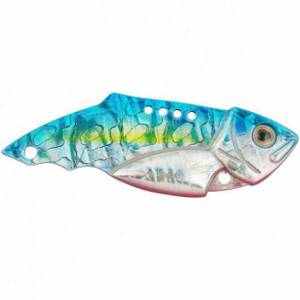
SPRO TEPPAN VIB 7GR Pike – good for catching large perch and pike perch. It is a variant of the previous spinner in a different color and weight solution.
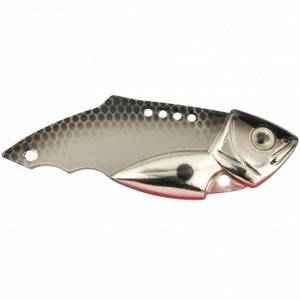
Sonaric 10.7 gr Metallic Oikawa – length 52 mm, works especially well on large perch and pike perch. Characterized by precise casting and durable varnish coating.

Description of the spinner
The Cicada spinner is a universal bait for spinning fishing. Externally, the spinner is similar to a homoptera insect - a cicada. This bait first appeared in the 50s in America, where it was called “bladebait”.
The Cicada spinner is made of metal materials, weight up to 17 g. When retrieving, it makes certain noises and vibrations, which attracts predatory fish. The spoon may have one or two hooks and several holes, which are needed so that the angler can change the degree of water resistance. The Cicada is excellent for catching predators: pike, pike perch, and perch. One of the main advantages is the low cost of the bait. In fishing stores the price does not reach 300 rubles, and the assortment is so diverse that your eyes widen.
Gear selection when using cicadas
For fishing with cicadas from the shore:
- Spinning rods with a length of 2.4 - 3 meters of medium action with a dough of 40-60 grams.
- The fishing line is a braided cord with a cross-section of 0.15 mm. It should be remembered that these baits are very picky about the fishing line. A little thicker line and the action of the bait freezes. The required cross-section can only be determined experimentally and depending on the body of water, current strength, wind strength and other factors. Therefore, in your fishing suitcase you need to have a good selection of cicadas and several types of fishing lines on spare spools.
- You can choose a universal reel with a spool of 2500-3000 with a gear of 5.0-5.2:1.
- When hunting pike, you need to use leashes made of metal, tungsten or Kevlar.
- To attach the spinner to the fishing line, a carabiner is used, connected to the main fishing line using a “loop-to-loop” method.
For fishing from a boat, the length of the rod should be 1.8 - 2.4 meters, the rest of the equipment parameters are the same.
Successful fishing techniques
Upon arrival at a reservoir, first of all it is necessary to assess its nature, depth, state of aquatic vegetation and weather conditions, especially lighting.
If there are holes, first fish them with heavy cicadas hooked to the middle holes - there may be large pike perch there. The wiring is similar to a jig. When wiring, you need to achieve the game of the cicada by selecting the speed. If frequent shocks are felt in your hand, the spinner is playing.
It is necessary to fish the boundaries of aquatic vegetation to detect pike in ambush. To do this, it is better to use an approximately 7-gram spoon with wiring under and along the surface.
In general, make the most of your experience and skills and success will come.
Spinning fishing
Cicada is an easy-to-learn bait that forgives beginners some mistakes and can catch fish even in the hands of an inexperienced fisherman. It allows for various animation techniques, but the basic technique is a banal uniform feed.
The speed of monotonous wiring can be varied within wide limits, adapting to fishing conditions and the mood of the predator. Additionally, this is facilitated by the presence of several holes, which allows you to vary the frequency and amplitude of vibrations of the spinner.
Fishing for cicadas with a spinning rod is not only about uniform retrieval. Experienced fishermen are well aware of the capabilities of this bait and use other technical techniques. Among them:
- wavy;
- sawtooth;
- stepped.
It is not difficult to perform a wavy spinner retrieve. After the bait falls to the bottom or reaches a certain depth, the angler takes out the slack in the thread and makes several turns with the reel. Then there is a pause and the cycle repeats.
The sawtooth animation looks somewhat more aggressive than the previous wiring. It is performed not only with the help of a reel, but also with the help of a rod. In the initial phase of feeding, it is necessary to pull the spinning rod up, blowing up the cicada. Then several revolutions are made with acceleration, and then a pause.
Step retrieving involves presenting the bait at the bottom by twitching the rod and then selecting slack in the line during a pause. In this case, the spoon moves in small steps, like a classic jig rig.
In all of the animation techniques listed above, special attention should be paid to the free fall phase of the bait. At this moment, the cicada makes damped oscillations, which have a positive effect on the predator, especially the passive one.
In general, the cicada is a very convenient bait. It's easy to control. The game is clearly conveyed to the hand, and the behavior of the spoon is intuitively clear to every novice angler. Combined with versatility and catchability, it turns into a formidable weapon of mass destruction of perch, pike perch and pike.
Wiring when using a cicada
Significant disadvantages of cicadas include the fact that, as a rule, cicadas like uniform wiring. An exception may be the case when the bait can be lowered on a stretched line, followed by a sharp jerk. The trajectory of movement resembles the teeth of a saw.
This kind of wiring should be distinguished from jigging, where you can play with the weight of the head within large limits. An option for uneven wiring is the so-called snap jigging. In this option, the bait must be lifted up with a sharp jerk of the spinning rod, then lowered to the bottom on a loose line.
It should be noted that small cicadas, weighing up to 7 grams, are very good for catching perch when it destroys fry in a school. Perches constantly bite off the tails of twisters and rippers, and the metal cicada catches them mercilessly and there are often cases of catching two perches at once. Moreover, unlike other baits, it has an excellent long-range and allows you to pursue a perch pot when it moves from considerable distances.
Technique for placing a cicada spinner
What kind of “tricky” fishing for pike perch is this? In principle - nothing special, but there is one subtlety that decides almost everything - you need to be able to control the tackle when falling. So, the first method is sinusoidal wiring, a kind of flat slide. I cast a cicada spoon and let it sink to a certain depth, controlling the fall. Then I pick up the slack and reel it in for a while, reeling in the cicada spoon, and then let it fall to the bottom again.
During the fall, just hold the tackle - the weight of the spoon will be enough for it to vibrate as it sinks, and it will also catch practically on its own. The second wiring is much more aggressive and resembles saw teeth. Here, too, the most important factor is the controlled fall of the cicada, but there is practically no horizontal component: the cicada falls, and at the lowest point you catch it, helping yourself not only with a reel, but also with a spinning rod, and sharply lift it up. Sometimes such work with a spinning rod is very active, sweeping, and the cicada spinner literally takes off, high and sharply, only to then fall again. And so time after time.
A very effective method in fast currents, with a depth of 2–2.5 m, when a 10-gram cicada will be more than enough. The method is effective, but requires considerable physical effort - wave at this pace for a couple of hours and you will understand. So choose your tackle carefully: the reel and spinning rod are reliable, powerful enough, but very light and well-balanced. A high-speed reel (for example, Mitchell Mag Pro Lite 500) with a gear of 6.2:1 and a reel of 0.86 m per turn of the handle would be most appropriate here. It would seem that there is little difference with the more usual 0.7 m winding and 5.2:1 reduction. But the second reel option will not allow you to properly control the tackle and fishing will turn into frustration and a waste of time, which happened more than once to those who fished near me.
Of the spinning rods, I especially recommend the EGI Sakura series. With a test weight of up to 25 g, a length of 2.44 m and a weight of 117 g, this spinning rod has a specific structure, is thin in the butt and maneuverable, and will allow you to solve all your problems. Finally, the third wiring is very neat. With the tip of the rod you force the cicada spinner to jump literally a few centimeters at the very bottom, sometimes just knock on it, raising a cloud of turbidity. A kind of jigging, alternating with pauses. Whether from a boat, from a rocky shore or from ice - such wiring simply excites even the apathetic fish of cold waters.
Features of catching a cicada in winter
The cicada’s real “trump card” is hunting pike perch in winter. A 14 gram spoon can be successfully caught from a depth of 20-25 meters if there is a fairly fast current in the fishing area. Modifying the cicada for winter conditions.
The modification consists of replacing the hooks and color characteristics of the spinners. It is better to replace standard hooks with 1-2 larger numbers. For successful fishing, a fluorescent strip is applied to the lure. See below for more details on color enhancements.
It should be noted that color in the conditions of a particular body of water can be decisive in the success of fishing.
Correct fishing technique
The operation of the basic cicada model during ice fishing is very unique. You can’t throw it like any other lure. And you can’t tap it on the bottom either, as the doubles often get caught on the thread.
When the cicada reaches the bottom, it must be smoothly raised by 1 - 1.5 meters, and the play of the spinner should be heard (a characteristic “tapping” on the hand). After a short pause, you should not quickly lower the bait with short swings of the nod.
The bite follows, as a rule, when moving downwards, the bite is decisive and angry. The acoustic noise created by the “wing” during ascent attracts predators from all over the area under the hole. This is basic wiring. There are up to five varieties of them, and each angler brings his own “tricks” into the game, for which the cicada feeds him with pike perch all winter.
Popular catchable forms
As already mentioned, the Cicada spinner is characterized by excellent aerodynamic performance, which cannot be reproduced by any other bait. The product is distinguished by the highest casting accuracy, as well as the ability to fly over vast distances, getting to the right place.
The “wings” of Cicadas can be concave or flat, and as fishing experience says, the second option demonstrates a better reaction on the part of the fish, since the presence of concave petals slightly impairs the naturalness of the game. At the same time, the probability of snagging on underwater debris and thickets is very high.
If the “wings” are not too concave, then fishing in an unpolluted reservoir will be quite effective. In this case, additional vibration will be created during the dive, as well as the body rummaging around.
Small Cicadas show increased performance, provided that the angler has a compact spinning blank with high sensitivity in his hand. If fishing is carried out at a depth of seven meters, then lonely, usually trophy, representatives of the species are easily caught by the spoon, since it is equipped with a double in the lower part, and this significantly increases the degree of successful bite.
Among the advantages of the bait, one should highlight its fast descent along the bottom, which is really important when searching for fish at impressive depths.
But, despite many disputes and discussions about the appropriate shape, weight and size, finding the ideal option for specific fishing conditions is possible only with an individual approach. After all, some people believe that there is simply nothing better than 7-gram Cicadas, while others use exclusively 9-12-gram baits, and still others use 25-gram baits. In any case, to increase the chances of successful fishing, it is better to take several baits with different indicators with you to the pond.
Tips for choosing
What color of spinner to use
The following recommendations can be given to this question:
- Golden – cloudy or cloudy water.
- Red – jig fishing at medium and deep depths and in cloudy conditions.
- Chartreuse - during the period when a cold front has passed and when visibility in the water is less than half a meter.
- Silver - on a clear day, in shallow water, in clear water, when trolling with bait at a long distance.
The surface of cicadas is made smooth, wavy or embossed.
In addition to the basic colors, the coating can be red, pink, or chartreuse. Color combinations are also used, for example “blue + chrome”.
Refinement of the cicada
If you want to change the color to any other, you can use the basic cicada, gluing special stickers that have a prismatic texture on it.
Especially for this purpose, Gritter Gitter Customs Wallei Tackie produces self-adhesive films in a variety of colors. Sticker colors can be combined:
- Transparent red.
- Small black and white.
- Transparent pearl.
- Dark green.
- And many others.
ZAP Lures produces prismatic films in silver, gold and chartreuse for most standard cicadas.
There is an opportunity to satisfy any desire of the fisherman. It is enough to purchase a standard size cicada blank for a dollar and a half and equip it with your own hooks, weights and clasps, color them according to your taste and desire.
Other methods are also used to correct the design of the spinner. For example, Scented Double markers come in two colors: red chartreuse and orange chartreuse. Moreover, these markers have a rich smell of garlic or cut fish, as an additional factor of attractiveness to predators.
Pieces of worms, maggots, heads or pieces of sprat are used as additional bait for the spoon. Additional bait does not interfere with the cicada's play if it is attached to the tee hook facing the body. Flavored gels are used to lubricate the body of the spinner, such as Smelli Jelli, which has an anise scent, one of the most attractive to fish, or Megastrike.
Appearance of a cicada
The shape of the cicada has some correspondence with insects and fish.
However, I cannot admit that external resemblance to the natural food of pike and perch is a guarantee of success. But I can say positively that he turned out to be an excellent provocateur.
By creating high-amplitude vibrations when retrieved, bladebaits produce powerful hydroacoustic waves, in which a predator rarely fails to try to test the “author.”
To enhance the “sound”, in addition to two tees or double hooks, petals are hung from the cicada.
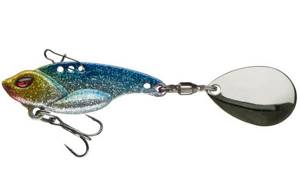
All cicadas are equipped with one, two or three mounting holes, which allows you to change the angle of inclination when guiding and obtain different vibrations.
When hooked to the first hole, the cicada creates high-frequency vibrations that the perch like so much. To get the most aggressive game, we focus on the latter. It is useless to give recommendations here - you have to select the attachment point while fishing.
Among the advantages we can also note:
- Thanks to the correct weight, the cicada is a good flyer and you can make a long cast and place the bait at the desired point even in windy weather.
- The specificity of cicadas makes it possible to fish in still water bodies and in the current, in shallow water and deep holes.
- If compared with the outwardly similar rattlins, then the cicada. With the same size, the spinning rod is less annoying.
Cicada tuning
As a rule, a lure bought in a store requires fine-tuning in relation to local conditions.
Fluorescent coating is popular: at a depth of about 10 meters darkness reigns and this coloring is more noticeable. The shine of the luminous bait is similar to the shine of scales, attracting a predator from afar, but for a confident bite he needs an “aiming point.”
It can be depicted in the area of the double using powdered phosphor, which must be mixed with any quick-drying varnish until it becomes creamy thick. The composition is applied to the spoon with a match. Then it is necessary to cover the mark with several layers of varnish, since the phosphor layer is rough and quickly becomes dirty.
When playing, cicadas create hydroacoustic waves, and if you wish, you can add to this such an effective factor as the sound from the eyes - rattles. In fact, the Heddon company (and not only) has long offered such a solution for these cicada spinners as standard.
However, the easiest way is to find a sewing supply store and buy doll eyes in the form of a dome. They are filled with small plastic balls that make noise when the bait plays.
And if there are representatives of the fair sex in the house, you can secretly use their nail polish. Mother-of-pearl varnishes are especially effective, giving a light effect in reflection, like from small scales.
Such a modification can increase the cicada's catchability by almost half.
What is a cicada spinner?
“Cicada”, “bladebait”, “metal vibe”, “blade” - all these are names of the same spinner, known to fishermen around the world since 1957, when the great James Heddon declassified his next brainchild and began its sale. This flat piece of metal, which has an unusually strong vibration, was, unfortunately, coolly received and forgotten for a long time by fishermen in favor of more familiar lures. But time has put everything in its place, and cicada spoons have rightfully taken their rightful place in the arsenal of anglers who hunt perch and pike perch.
However, this spoon turned out to be no less effective when catching pike, catfish and even... asp, you just need to not be afraid to fish with it and experiment with wiring. Extremely compact, armed with a pair of double hooks and maintaining a vertical position in the water when guiding, cicadas are irresistible to a predator! Well, tell me, what other lure can be thrown so far and sink so quickly? These exceptional abilities allow a knowledgeable fisherman to fish at a great distance from himself, fish the most extensive areas and get fish from the bottom, half-water or from shallow water. It is enough to select the weight of the cicada spinner, start retrieving in time, and you can fish from the shore or from a boat, from a meter deep or from twenty meters!
We have already said that strong vibration is the “trick” of these spinners. Cicadas begin to work at the slightest stretch, and they can be driven very slowly, which is especially good in cold water, or if the fish is passive and cautious. Conversely, if you need to find a predator in vast and unfamiliar areas, you should take advantage of the exceptional stability of the cicadas and move the lure at maximum speed. Of course, an experienced angler will use this technique if the water is warm enough and the fish are active. Try to develop a sense of intuitive understanding of where the fish are at this time of year, how they behave at this morning or evening hour... For example, as soon as the water becomes warmer than 11–12°C, I increase the speed of the retrieve to force the predator to react .
Blitz tips
- When planning to fish for a cicada for the first time, take with you several spare spools with different thicknesses of main lines. The cicada is very demanding on the thickness and rigidity of the fishing line. The cicada will not play with an excessively stiff fishing line.
- You need to have several decorative films of different colors with you so that you can experiment with colors.
- Place a bottle of bright pearlescent nail polish in your fishing bag. This can always add an effective bright spot to the color, complementing the play of the bait with optical phenomena.
- It wouldn’t hurt to have a few bottles of darkening varnishes in your suitcase; they can come in handy in bright weather.
- Don't be afraid to experiment. The cicada will definitely respond to your concern.
The cicada spinner - a bladebait - not only perfectly catches any fish, it gives room for imagination, using which anglers can easily adapt this bait to their fishing conditions and achieve excellent results. If you haven’t caught a cicada yet, buy it! And neither your tail nor your scales!
